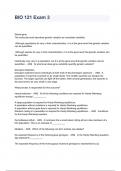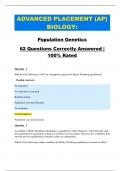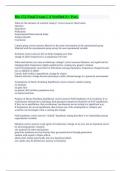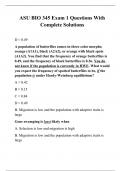Hardy weinberg Study guides, Class notes & Summaries
Looking for the best study guides, study notes and summaries about Hardy weinberg? On this page you'll find 763 study documents about Hardy weinberg.
Page 2 out of 763 results
Sort by
Gizmos Hardy-Weinberg Equilibrium 2024 | All Answers are 100% Correct

-
Biology 1108 Unit 1 EXAM Questions and Answers 100% Pass
- Exam (elaborations) • 28 pages • 2024
-
- $12.49
- + learn more
Biology 1108 Unit 1 EXAM Questions and Answers 100% Pass The term "n" refers to the size of a population, that is, the number of individuals in that population. In general, in a sample of n individuals, the frequency of an allele is: A)the number of occurrences of the allele. B)the number of occurrences of the allele divided by n. C)the actual value of n D)the number of occurrences of the allele divided by twice the number of individuals in the sample (2n). E)twice the number of occur...

-
BIO 121 Exam 3 Questions And Answers
- Exam (elaborations) • 23 pages • 2023
- Available in package deal
-
- $12.49
- + learn more
BIO 121 Exam 3 Questions And Answers Whole-gene The molecular level describes genetic variation as nucleotide variability. Although populations do vary in their characteristics, it is at the gene level that genetic variation can be quantified. Although species do vary in their characteristics, it is at the gene level that genetic variation can be quantified. Individuals may vary in a population, but it is at the gene level that genetic variation can be quantified. - ANS At wha...

-
ASU General Biology (Bio 181) Gizmos Student Exploration of Hardy Weinberg Equilibrium with Answers Arizona State University
- Exam (elaborations) • 7 pages • 2024
- Available in package deal
-
- $14.49
- + learn more
Completed Lab: Gizmos Student Exploration of Hardy Weinberg Equilibrium. Student Lab handout with all answers.

-
Optometry Admission Test || A+ Verified Solutions.
- Exam (elaborations) • 49 pages • 2024
-
- $17.49
- + learn more
Which of the following is the mRNA start codon in most cases? correct answers AUG Which of the types of RNA is the smallest? correct answers tRNA Which of the following is NOT considered a pyrimidine? correct answers G Which of the following ARE considered a pyrimidine? correct answers - Cytosine, Thymine, and Uracil - One-carbon nitrogen ring bases Which of the following is correctly paired set of DNA nucleotides? correct answers C-G A-T What are the building blocks of amino a...

-
BIO 315 Exam 4 Questions and Answers 100% Pass
- Exam (elaborations) • 18 pages • 2024
-
- $12.49
- + learn more
BIO 315 Exam 4 Questions and Answers 100% Pass aa - Correct Answer ️️ -albinism heterozygous parents - Correct Answer ️️ -25% chance of offspring having recessive disease population - Correct Answer ️️ -group of individuals of same species living in the same area population genetics - Correct Answer ️️ -study of all alleles in a population gene pool - Correct Answer ️️ -all the alleles in a population gene flow - Correct Answer ️️ -the movement of alleles between ...

-
ADVANCED PLACEMENT (AP) BIOLOGY: Population Genetics 62 Questions Correctly Answered | 100% Rated
- Exam (elaborations) • 29 pages • 2023
- Available in package deal
-
- $12.00
- + learn more
ADVANCED PLACEMENT (AP) BIOLOGY: Population Genetics 62 Questions Correctly Answered | 100% Rated Question 1 Which of the following is NOT an assumption required for Hardy-Weinberg equilibrium? Possible Answers: No migration No selection is occurring Random mating Population size must fluctuate No mutations Correct answer: Population size must fluctuate Question 2 According to Hardy-Weinberg calculations, a population's allele frequency will remain the same from generatio...

-
Bio 152 Final Exam || A Verified A+ Pass.
- Exam (elaborations) • 28 pages • 2024
- Available in package deal
-
- $13.49
- + learn more
What are the elements of scientific inquiry? correct answers Observation Question Hypothesis Predictions Experimental/Observational Study Analyze Results Conclusion Control group correct answers Must be in the same environment as the experimental group Matched with the experimental group except for one experimental variable Evolution correct answers life on Earth changing over time change in allele frequencies in a population over time What mechanisms can cause evolutionary chan...

-
ASU BIO 345 Exam 1 Questions With Complete Solutions
- Exam (elaborations) • 29 pages • 2023
-
- $12.99
- + learn more
D ≈ 0.49 A population of butterflies comes in three color morphs; orange (A1A1), black (A2A2), or orange with black spots (A1A2). You find that the frequency of orange butterflies is 0.49, and the frequency of black butterflies is 0.36. You do not know if the population is currently in HWE. What would you expect the frequency of spotted butterflies to be, if the population is under Hardy-Weinberg equilibrium? A ≈ 0.42 B ≈ 0.15 C ≈ 0.84 D ≈ 0.49 B. Migration is low and the populat...

-
Biology 1108 Unit 1 EXAM Questions and Answers 100% Pass
- Exam (elaborations) • 28 pages • 2024
-
- $12.49
- + learn more
Biology 1108 Unit 1 EXAM Questions and Answers 100% Pass The term "n" refers to the size of a population, that is, the number of individuals in that population. In general, in a sample of n individuals, the frequency of an allele is: A)the number of occurrences of the allele. B)the number of occurrences of the allele divided by n. C)the actual value of n D)the number of occurrences of the allele divided by twice the number of individuals in the sample (2n). E)twice the number of occur...

How much did you already spend on Stuvia? Imagine there are plenty more of you out there paying for study notes, but this time YOU are the seller. Ka-ching! Discover all about earning on Stuvia



